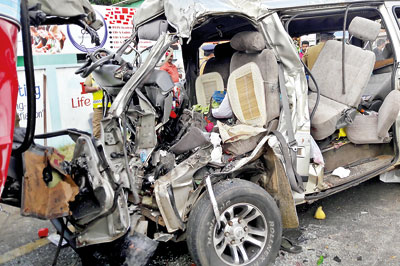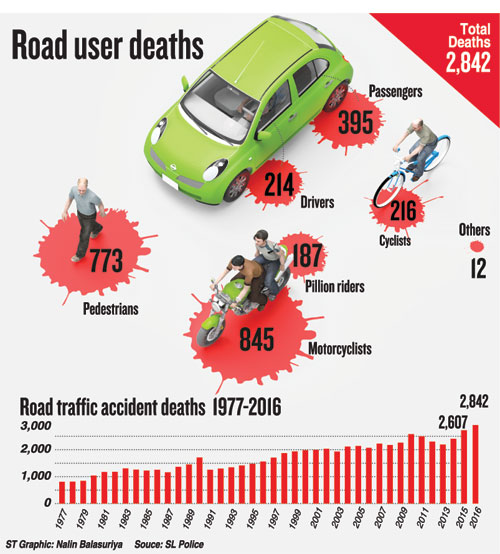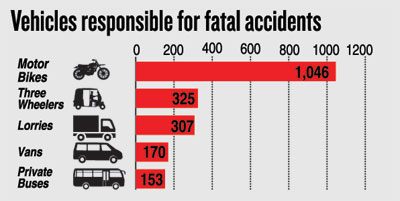News
Sleepy drivers on a crash course
 Sleepy drivers are deadly drivers and they are being asked to wake up to the destruction they are causing to human lives.
Sleepy drivers are deadly drivers and they are being asked to wake up to the destruction they are causing to human lives.
Physicians and experts on transport issues, say that lack of sleep impairs the ability to drive and that those who are exhausted should not be allowed to take the wheel. They also say passengers should watch out for warnings signs such as when a driver begins to nod and can’t keep the vehicle steady.
As for policing, law enforcers propose shift work for overworked traffic police, mobile patrols in unmarked cars and motorbikes and also suggest creating public awareness of quick action when hit-and-run accidents occur.
Police Traffic Chief, Deputy Inspector General (DIG) of Police Palitha Fernando said drowsiness and high incidence of drink driving contributed to road traffic accidents. He adds that the laws are being enforced effectively.
He also cited inexperience among drivers and motorcyclists also as contributory factors to road traffic accidents.
“There are inexperienced drivers who have not had basic training. I think authorities must look into this. The department of motor traffic should take this into consideration,’’ he added.


| Many killer drivers don’t have licences So far this year, 2,842 people have been killed in more than 2,600 road traffic accidents, police data show. This meant that 235 more people died this year than in 2015. As of early this December,187 road traffic accidents caused 207 deaths. This year, 773 pedestrians were killed, as well as 845 motorcyclists and 187 pillion riders. Among those killed were 214 drivers, 395 Passengers. Also killed were 216 cyclists and a dozen others. The biggest number of fatal accidents, 1,046, was caused by motorcycles followed by three-wheelers which killed 325 people. Lorries caused 307 deaths while private buses killed 153 people and vans ended the lives of 170 innocents. A doctor was among the most recent accident victims. Three persons including a doctor died when a pick-up truck crashed into a lorry on December 27 in Navakkulama while travelling to Jaffna from Colombo. The victims, were Dr. Ashomi Sudeshika from the Colombo National Hospital and both her mother and father-in-law. Dr Sudeshika’s husband was hospitalised due to his injuries. Police said the driver of the lorry has surrendered. On the same day, one person died when a van and a motorcycle collided on the Polonnaruwa-Onekama road. The motorcycle rider, a 50-year-old father of three was killed. The driver of the van was arrested, police said. This year more than 45,000 people have been prosecuted for drinking and driving, compared with 47,992 in 2015. Police alone cannot contain road traffic accidents, an official of the National Road Safety Council said. “We have already implemented a provincial structure to curb the number of accidents. This is the 10-year road safety plan. We have implemented the plan in districts including Kalutara, Colombo and Gampaha,” the official said, adding that the number of deaths a day has increased from five to seven on average. Official records show that, 35 per cent of drivers responsible for fatal accidents did not possess valid licences, the worst offenders being motorcyclists, who made up nearly 50 per cent of that number followed by lorry drivers at 14 per cent and van drivers at 11 per cent. The Secretary of Automobile Association Ceylon, Dewapriya Hettiarachchi said that about half of all accidents were caused by drivers who did not have a licence or who had less than three years’ driving experience. Drunken driving was mainly reported from areas between Galle and Chilaw while accidents in other areas were mainly caused by speeding. He added that the driving test conducted by the Department of Motor Traffic was far from satisfactory. “There is a lack of theory tests, especially on road rules, road manners and courtesy. The driving test is conducted during the day, from Werehera and Borelesgamuwa. There are no tests in busy cities or roads and no testing is done during night-time,” he said. |
He said that in the past, traffic police deployed mobile patrols to detect violators of road rules but that this is not being done efficiently now because there are not enough trained traffic policemen.
To deal with those who fall asleep at the wheel, former traffic police chief Camillus Abyegoonewardene, suggests raising awareness about the behaviour of such drivers.
“The behaviour of the driver should alert the passengers,’’ he said. These drivers take more risks, yawn frequently, are seen nodding, and blinking. They show no interest in carrying on a conversation with those in the vehicle. “More alarming signs include the driver becoming irritable, restless, shifting in his seat, insisting they are all right when asked about possible problems, driving in a zigzag manner, missing road signs and irrational speeding and braking.’’
He said driver training schools must be asked to include lessons on the dangers of fatigue and driving while drowsy.
Dr. Harsha Perera, a physician at Colombo National Hospital said drivers underestimate the level of fatigue, its consequences and they overestimate their ability to perform and overcome the effects of fatigue coupled with a low perceived threat of the dire consequences of an accident.
He said drivers who feel drowsy, open the window to let in air, lower the temperature in the cabin, splash water on their faces, stop to take a brief walk, or talk to themselves.
Traffic safety experts advise drivers to take a brief nap in a safe location rather than continue driving when they fell sleepy.
They say most crashes or near misses occur between midnight and 2:00am, as well as4:00 a.m. to 6:00 a.m. Road traffic accidents are also frequent between 2:00 p.m. and 4:00 p.m.
An expert on transport, Professor Amal Kumarage, said that those who reported sleeping six or fewer hours a night faced an increased risk of collisions. “One in seven licensed drivers aged between 16-24 admits having fallen asleep at least once while driving in the past year and that 10 per cent of all drivers say they’ve dozed off at the wheel,’’ he said.
He said introducing tactile edges to roads could help reduce traffic accidents caused by sleepy drivers.

